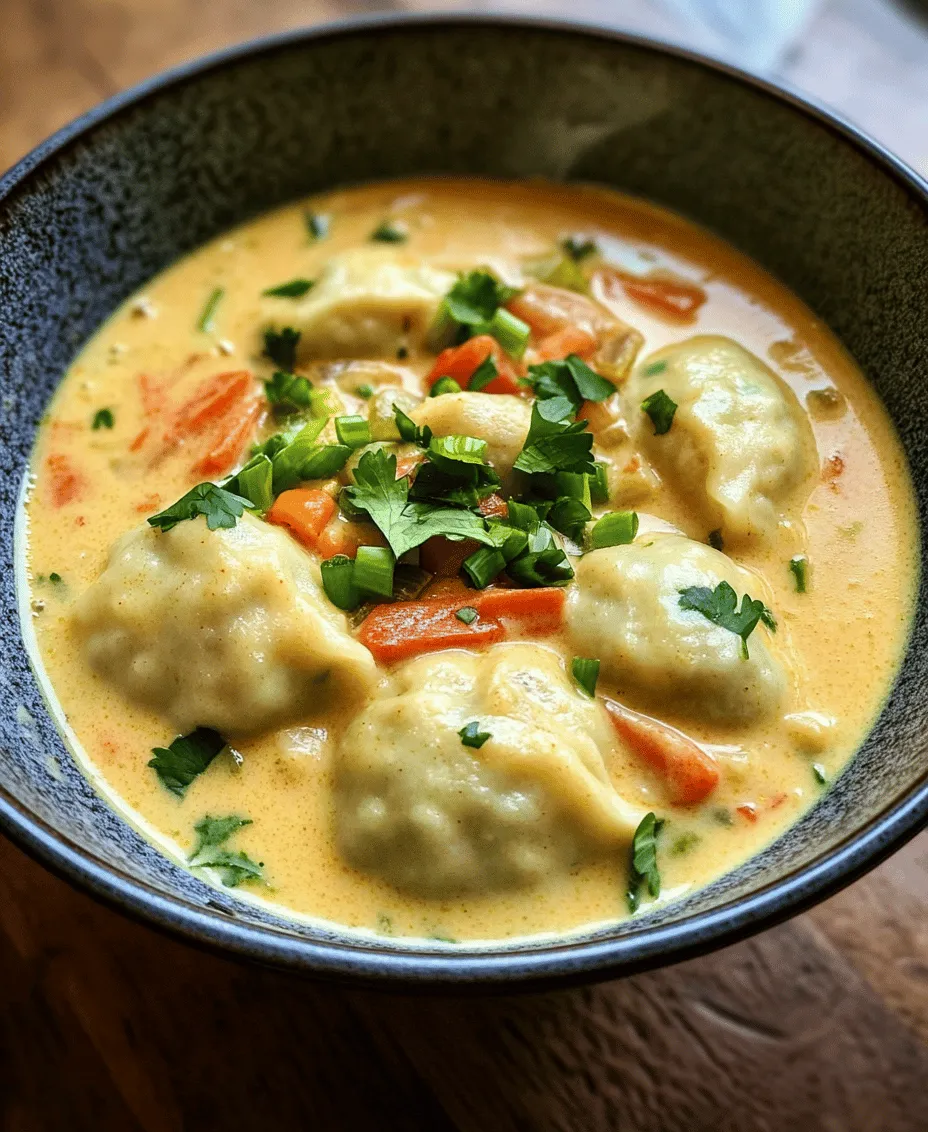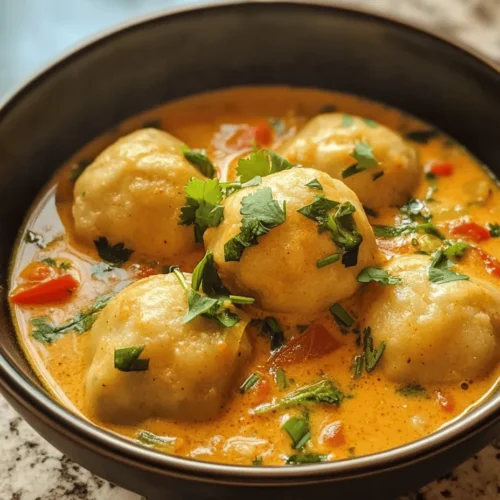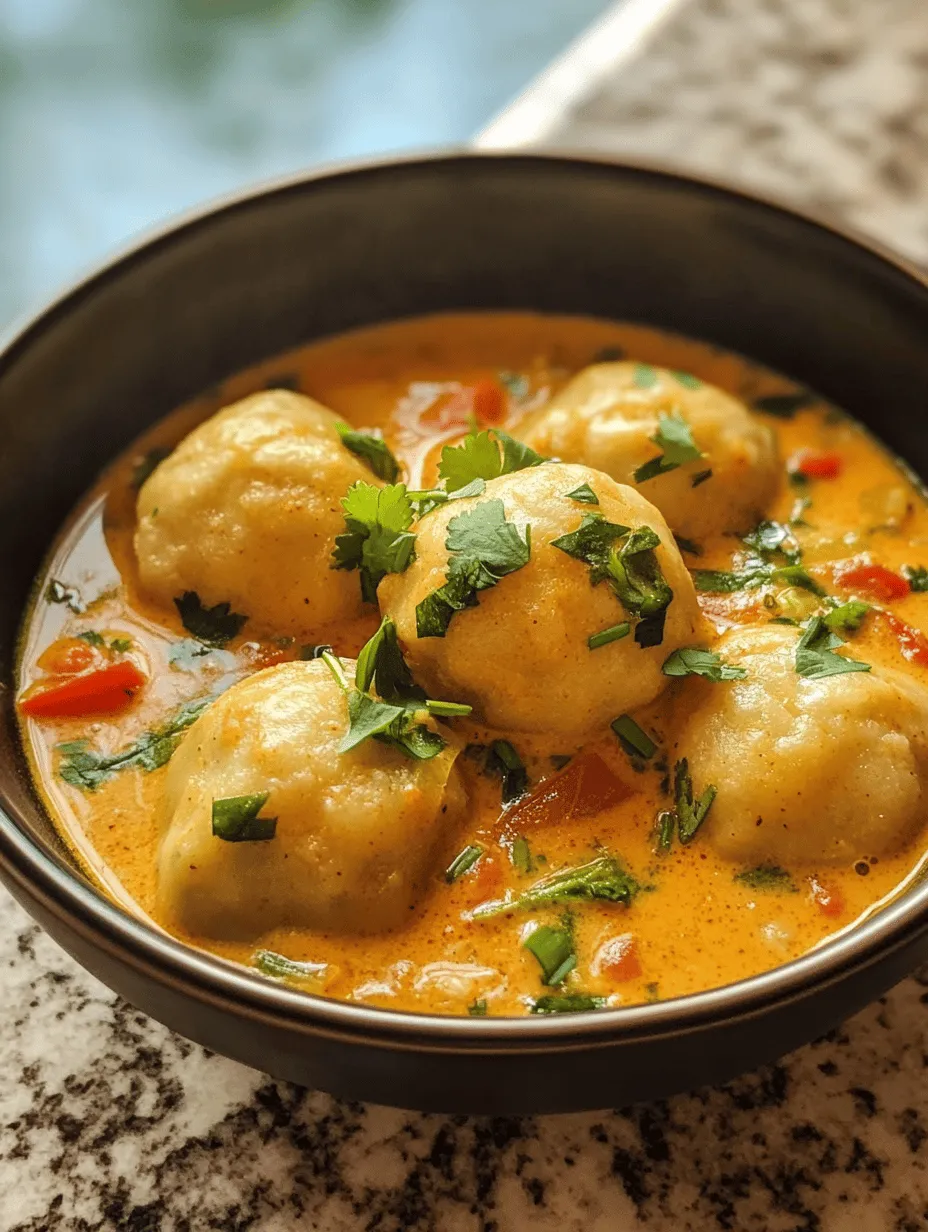Introduction
Curry dumpling soup is a delightful fusion dish that brings together the warmth of comforting soup and the satisfying bite of tender dumplings, creating an experience that is both heartwarming and delicious. This dish stands out for its rich, aromatic flavors and diverse textures, making it a beloved choice for many who seek both comfort and nourishment in a bowl. The combination of savory broth, succulent dumplings, and vibrant spices transforms a simple meal into an unforgettable culinary experience.
The appeal of curry dumpling soup lies not only in its taste but also in its versatility. It can be tailored to suit various dietary preferences, whether you’re a meat lover, a vegetarian, or even a vegan. The harmony of flavors—from the earthy spices of curry to the fresh crunch of vegetables—creates a balance that is both satisfying and invigorating.
The origins of curry dumpling soup can be traced back to the rich traditions of Asian cuisine, where dumplings are a staple in many cultures, often filled with a variety of ingredients and served in flavorful broths. In Southeast Asia, curry is a beloved flavor profile, renowned for its complexity and depth, often incorporating elements like coconut milk, fresh herbs, and spices. This recipe pays homage to those traditions, providing a comforting bowl that showcases the best of both worlds.
Understanding the Ingredients
To create the best curry dumpling soup, it is essential to understand the roles that each ingredient plays in crafting this delightful dish. The key components encompass dumpling ingredients, soup ingredients, and seasonings, each contributing to the overall flavor and texture.
Dumpling Ingredients
1. Flour: The backbone of any dumpling, flour is crucial for providing the structure and texture. All-purpose flour is commonly used, but for a chewier texture, you might consider using a combination of all-purpose flour and glutinous rice flour. The choice of flour will affect how the dumplings hold their shape and how tender they are when cooked.
2. Water and Olive Oil: These ingredients are vital for hydrating the dough. Water provides the necessary moisture for the flour to form gluten, which gives the dumplings their elasticity. Olive oil is added for flavor and to create a more tender dough, preventing it from becoming too tough during the cooking process.
3. Salt: A small but significant ingredient, salt enhances the overall taste of the dumpling dough. It helps to balance flavors and can even improve the texture of the dumplings by strengthening the gluten formation.
4. Vegetables: The filling of the dumplings often includes finely chopped vegetables, which not only add nutrition but also contribute vibrant colors and flavors. Common choices include cabbage, carrots, and scallions. Each vegetable brings its unique taste and texture, creating a delicious medley that complements the curry flavor.
5. Protein Options: The versatility of the dumpling filling allows for various protein options. Ground meat such as chicken, pork, or beef can be used, or you can opt for plant-based proteins like tofu or tempeh for a vegetarian or vegan version. The choice of protein will influence the flavor profile and heartiness of the dumplings.
6. Seasonings: Seasonings such as soy sauce and sesame oil are essential for adding depth of flavor to the filling. Soy sauce provides a savory umami taste, while sesame oil adds a nutty aroma that enhances the overall flavor of the dumplings.
Soup Ingredients
1. Broth: The soup base is critical for flavor and nutrition. You can use a homemade broth or a store-bought version. Chicken broth, vegetable broth, or a combination of both works well. The broth should be rich and flavorful, providing the foundation for the rest of the soup.
2. Coconut Milk: This ingredient adds a creamy richness to the soup, balancing the spices and giving it a luxurious texture. Coconut milk is a staple in many Southeast Asian dishes and complements the curry flavors beautifully.
3. Red Curry Paste: The star of the dish, red curry paste, is a blend of spices that includes red chilies, garlic, lemongrass, and galangal. This paste is what gives the soup its signature heat and depth. You can adjust the amount of curry paste based on your heat preference, making it milder or spicier as desired.
4. Aromatics: Fresh ginger and garlic are essential for adding fragrance and complexity to the soup. They should be sautéed at the beginning of the cooking process to release their flavors, creating a fragrant base for the broth.
5. Fish Sauce vs. Soy Sauce: Both fish sauce and soy sauce can be used to enhance the soup’s flavor. Fish sauce adds a distinct salty and umami kick that is common in Thai cuisine, while soy sauce is a great alternative for a vegetarian or vegan option. Each brings its character to the dish, so choose based on your dietary preferences.
6. Lime Juice: Fresh lime juice is the finishing touch that brightens the soup, adding a zesty kick that balances the richness of the coconut milk and the warmth of the curry. It enhances the overall flavor and provides a refreshing contrast to the other ingredients.
Step-by-Step Preparation of Dumplings
Creating the dumpling dough is a crucial first step in making curry dumpling soup. The process is straightforward, but it requires patience and attention to detail to achieve the perfect texture.
Making the Dumpling Dough
1. Combine Dry Ingredients: In a large mixing bowl, combine the all-purpose flour and salt. Whisk them together to ensure even distribution of the salt.
2. Add Wet Ingredients: Gradually add warm water and olive oil to the dry ingredients. Start by pouring in a little water, mixing it with a fork or your fingers. Continue to add water until the mixture begins to come together into a rough dough.
3. Knead the Dough: Transfer the dough to a lightly floured surface. Knead the dough for about 5 to 10 minutes until it becomes smooth and elastic. This step is crucial as it develops the gluten structure, which gives the dumplings their chewiness.
4. Rest the Dough: Once kneaded, wrap the dough in plastic wrap or cover it with a clean towel and let it rest for at least 30 minutes. Resting allows the gluten to relax, making it easier to roll out the dough later.
Preparing the Filling
While the dough is resting, you can prepare the filling for the dumplings.
1. Chop Vegetables: Choose your vegetables and finely chop them. For a balanced filling, aim for a mix of textures and colors. Common options include shredded cabbage, diced carrots, and sliced scallions.
2. Prepare Protein: If using meat or tofu, make sure it is finely minced or crumbled to ensure even distribution throughout the dumpling filling. Season the protein with soy sauce, sesame oil, and any additional spices you desire.
3. Combine Ingredients: In a mixing bowl, combine the chopped vegetables and protein. Mix well to ensure all ingredients are evenly distributed. Taste the filling and adjust the seasoning if necessary.
Forming and Sealing Dumplings
Once your dough has rested and the filling is ready, it’s time to shape the dumplings.
1. Roll Out the Dough: Divide the rested dough into small portions. On a lightly floured surface, roll out each portion into a thin circle, about 3 to 4 inches in diameter. The goal is to have thin edges and a slightly thicker center to hold the filling.
2. Add Filling: Place a small spoonful of filling in the center of each dough circle. Be careful not to overfill, as this can make sealing difficult.
3. Seal the Dumplings: Moisten the edges of the dough with a little water. Fold the dough over the filling to create a half-moon shape. Pinch the edges together firmly to seal, ensuring there are no air pockets inside. For a decorative touch, you can pleat the edges or use a fork to crimp the seal.
As you complete each dumpling, place them on a lightly floured surface or a parchment-lined tray to prevent sticking. Once all dumplings are shaped, you are ready to cook them and assemble your delicious curry dumpling soup.
This recipe not only embodies the essence of comfort food but also brings a touch of cultural richness to your dining table. With its balance of flavors and textures, curry dumpling soup is sure to become a favorite in your kitchen, providing warmth and satisfaction in every bite. Stay tuned for the next part where we will delve into the soup preparation and cooking techniques that bring this delightful dish together.

Visual Cues for Doneness and Shape
When preparing your curry dumplings, it’s essential to recognize the right visual cues to ensure they are perfectly cooked. The shape of the dumplings should be plump and slightly translucent, indicating that the dough has cooked through. Look for a smooth surface and a slight sheen, which indicates that the dumpling is ready to be served. Additionally, when the dumplings float to the surface of the soup, this is a reliable sign that they are done cooking. If you’re using store-bought dumplings, check the package instructions for specific cooking times, but these general guidelines will help you achieve the desired results.
Crafting the Soup Base
To elevate your curry dumpling soup, starting with a robust and aromatic soup base is crucial. The first step is to prepare your aromatic base, which typically includes finely chopped onions, ginger, and garlic. Begin by heating a generous amount of cooking oil in a large pot over medium heat.
Importance of Sautéing Ginger and Garlic
Once the oil is hot, add the diced onions, stirring frequently until they become translucent. This process usually takes about 5-7 minutes. Next, introduce minced ginger and garlic into the pot. Sautéing these aromatic ingredients not only enhances their flavors but also releases essential oils that contribute to the overall aroma of your soup. Cook them for about 1-2 minutes until fragrant; be careful not to let them burn, as this can impart a bitter taste to your soup.
Incorporating Curry Flavor and Its Significance
After the ginger and garlic have been sautéed, it’s time to incorporate your chosen curry spice blend. Whether you prefer a mild yellow curry or a more robust red curry paste, this is where the magic happens. Stir in about 2-3 tablespoons of curry paste or powder, letting it cook for an additional 1-2 minutes. This step allows the spices to bloom, enhancing their flavors and infusing the oil with their essence.
How to Balance Spice Levels
Balancing the spice levels is crucial for achieving a well-rounded flavor profile. If you’re unsure how spicy you want your soup, start with a smaller amount of curry paste and gradually add more, tasting as you go. Remember, you can always add more, but it’s difficult to tone down spiciness once it’s in the pot.
Adding Broth and Coconut Milk
Once your spices are fragrant and well incorporated, it’s time to add the broth. Pour in about 4 cups of vegetable or chicken broth, stirring well to combine all ingredients. Then, add a can of coconut milk for creaminess and richness. The coconut milk not only enhances the flavor but also helps to mellow the heat of the curry. Allow the mixture to come to a gentle simmer, and let it cook for about 10-15 minutes to meld the flavors.
Tips for Achieving the Right Consistency and Flavor
To achieve the perfect consistency for your soup, keep an eye on the liquid levels. If the soup seems too thick, add a bit more broth or water to reach your desired consistency. If it’s too thin, let it simmer a bit longer to reduce and thicken. Taste your soup before adding the dumplings; if needed, adjust the seasoning with salt, pepper, or additional curry spices.
Cooking the Dumplings in Soup
With your soup base ready, it’s time to cook the dumplings. Gently add them to the simmering soup one by one, ensuring they have enough space to cook evenly. Stir carefully to prevent them from sticking together or to the bottom of the pot.
Importance of Cooking Time and Monitoring Doneness
Cooking time for dumplings can vary based on their size and whether they are homemade or store-bought. Most dumplings will need about 5-7 minutes in the simmering soup. During this time, it’s crucial to monitor their doneness closely.
Visual Indicators for Perfectly Cooked Dumplings
As the dumplings cook, they will start to float to the surface, which is a primary indicator that they are done. Additionally, you can check their texture; they should feel firm yet tender. If you have made homemade dumplings, you might notice a slight sheen on the surface, indicating they are fully cooked.
Finishing Touches and Garnishing
Adding finishing touches to your curry dumpling soup is what elevates it from good to great. Just before serving, squeeze fresh lime juice into the soup. This brightens the flavors and adds a refreshing tang that complements the richness of the curry and coconut milk.
Suggestions for Garnishes: Cilantro and Green Onions
For garnishing, consider fresh cilantro and sliced green onions. These herbs add a burst of color and freshness, enhancing the overall presentation of the dish. You can also sprinkle some chili flakes or sesame seeds on top for an added pop of flavor and texture.
Presentation Ideas for Serving
When serving your curry dumpling soup, consider using deep bowls to showcase the vibrant colors of the soup and dumplings. You might also want to serve it with lime wedges on the side, allowing guests to customize their soup to their taste. A sprinkle of fresh herbs on top just before serving will make your dish look even more appetizing.
Nutritional Benefits of Curry Dumpling Soup
Curry dumpling soup is not just a comforting meal; it also packs a nutritional punch. The ingredients used in this recipe provide various health benefits.
Overview of the Health Benefits of the Ingredients
Curry spices, such as turmeric and ginger, are known for their anti-inflammatory properties and can aid digestion. Coconut milk adds healthy fats, which can contribute to heart health when consumed in moderation. The vegetables in your broth provide essential vitamins and minerals, making this dish a well-rounded meal.
Discussion on Balancing Comfort Food with Nutrition
While comfort food often gets a bad rap for being unhealthy, this curry dumpling soup serves as a reminder that comfort can also be nutritious. By using whole, natural ingredients, you can enjoy a satisfying meal that nourishes your body and soul.
Potential Dietary Modifications for Various Diets
This recipe can be easily modified to accommodate different dietary needs. For a gluten-free option, ensure that your dumpling wrappers are made without gluten or use rice paper. To make it vegetarian, stick with vegetable broth and add more vegetables or plant-based proteins. The flexibility of this recipe makes it accessible to many dietary preferences.
Cultural Significance and Variations
Curry dumplings have cultural origins that span various regions, particularly in Asian cuisines. Often seen as a comfort food, they hold significant value in family gatherings and celebrations.
Exploration of the Cultural Origins of Curry Dumplings
Curry dumplings are prevalent in many Asian cultures, with each region adding its unique spin. For instance, Chinese dumplings often feature a delicate dough with a variety of fillings, while Indian-style dumplings might be spiced with traditional masalas. Understanding these cultural backgrounds adds depth to the meal and connects us to the culinary traditions of others.
Discussion on Regional Variations and Adaptations
Regional variations can be delightful to explore. In Southeast Asia, you might find curry dumplings served with a spicy dipping sauce, while in India, they may be part of a larger thali. Experimenting with local spices and flavors can lead to unique adaptations that reflect your culinary style.
Ideas for Ingredient Substitutions Based on Local Cuisine
Feel free to adapt the recipe based on local ingredients you have available. If you can’t find coconut milk, consider using almond milk or another creamy substitute. Seasonal vegetables can also be swapped in for the ones listed, tailoring the soup to what’s freshest at your local market.
Conclusion
In summary, this curry dumpling soup is the perfect combination of comfort and flavor, making it a delightful addition to your culinary repertoire. With its aromatic base, perfectly cooked dumplings, and vibrant garnishes, it’s a dish that brings warmth and satisfaction to any meal.
The versatility of this recipe allows for endless variations, whether you’re catering to dietary preferences or exploring different cultural interpretations. The health benefits of the ingredients further reinforce that you can indulge in comfort food without sacrificing nutrition.
As you embark on this cooking adventure, remember the joy of sharing food with loved ones. Gather around the table, savor the rich flavors, and create memories that will last a lifetime. Enjoy the process of cooking and the satisfaction of a nourishing, homemade meal that brings happiness to your home.



